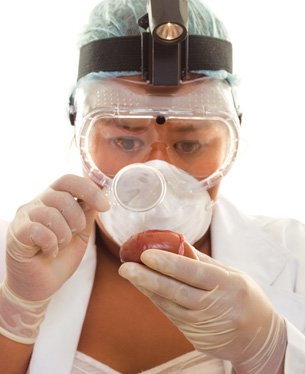Module 5
1. Module 5
1.5. Page 3
Module 5—Cell Division: The Processes of Mitosis and Meiosis
 Watch and Listen
Watch and Listen
In Unit B you considered the creation of sperm and eggs and how they unite to start a new human life. You discovered how the zygote undergoes continuous cell division and differentiation to eventually become a new person. This lesson identified the processes of mitosis, for growth and differentiation, and meiosis, for sperm and egg production.
Watch the animation comparing mitotic and meiotic cell division. Without worrying about the specific steps in either process, which will come in a later lesson, use this video to gain a general understanding of how these processes differ. As you watch the video, answer these questions:
- How does the cell prepare for either type of division?
- What structures are involved during the processes?
- How many daughter cells usually result from meiosis or mitosis?
- How do the daughter cells of mitosis compare with those from meiosis?
- In what ways is mitosis similar to meiosis? How is it different?
Record your thoughts in your course folder.
 Try This
Try This
It is difficult to observe cell division “in action.” However, some tissues in plants or animals are undergoing such rapid growth that observation of that area under a microscope can reveal several cells frozen in a stage of division. A common area to investigate is the tips of roots.
Open the microscope simulation. Choose “onion root tip, mitosis.” Explore this slide under various magnifications. Try to locate cells that are dividing. (Tip: Cells that are dividing have condensed chromosomes, so they appear as small dark worms instead of a vague mass.) To record your observation, place the pointer on one dividing cell and take a screen capture. Save your findings in your course folder.
 Module 5: Lesson 1 Assignment
Module 5: Lesson 1 Assignment
For your Lesson 1 Assignment, you will complete a lab. You will have the choice of completing a lab simulation or an investigation from your textbook. Either choice will ask you to complete questions in the Module 5: Lesson 1 Assignment Booklet.
Go to the “Modelling a Human Karyotype” lab now.
Save your completed assignment in your course folder. You will receive instructions later in this lesson about when to submit your assignment to your teacher.

© Leah-Anne Thompson/shutterstock
 Discuss
Discuss
Cell division can be dramatic and amazing. From a tiny sperm and egg comes a complete new person. Once a person reaches maturity, however, ther growth and repair are less dramatic—broken bones mend and cuts heal.
In the past, when a person lost a finger or an ear, nothing could be done. That may not be the case now. Regrowth of fingertips has been reported with the addition of ground-up pig bladder (a source of stem cells). Perhaps more amazing is the experimentation with growing human tissue or organs inside other animals.
Use the Internet search terms “mouse, human ear, BBC” and follow the link to the BBC website on “Artificial Liver ‘could be grown’” or “Girl may be the first to grow artificial ear.” In both of these reports there is a picture of a human ear growing on the back of a mouse for transplant.
As promising as these developments are, they raise many ethical questions. Should scientists be experimenting with tissue or organ regrowth using animals? Discuss this question with your classmates and your teacher in the discussion area.